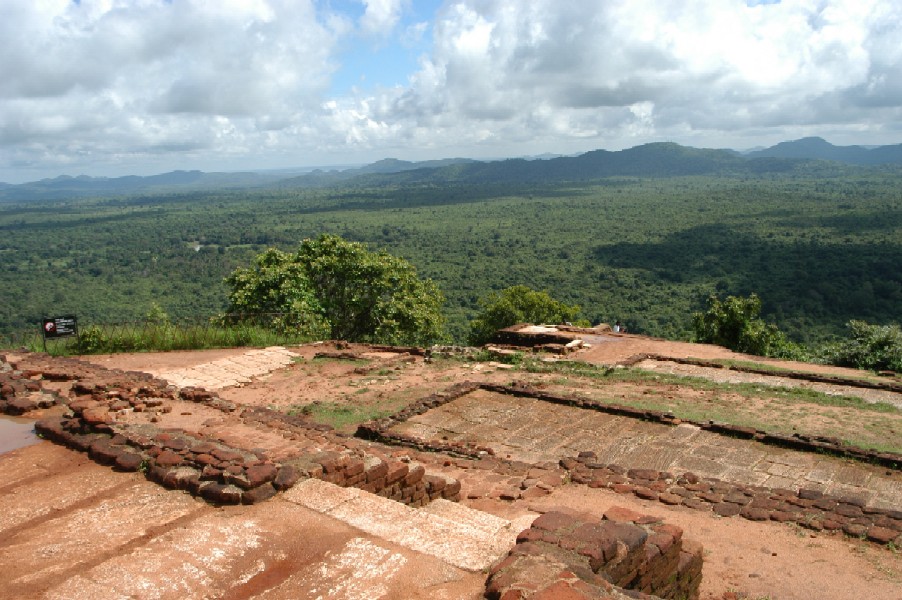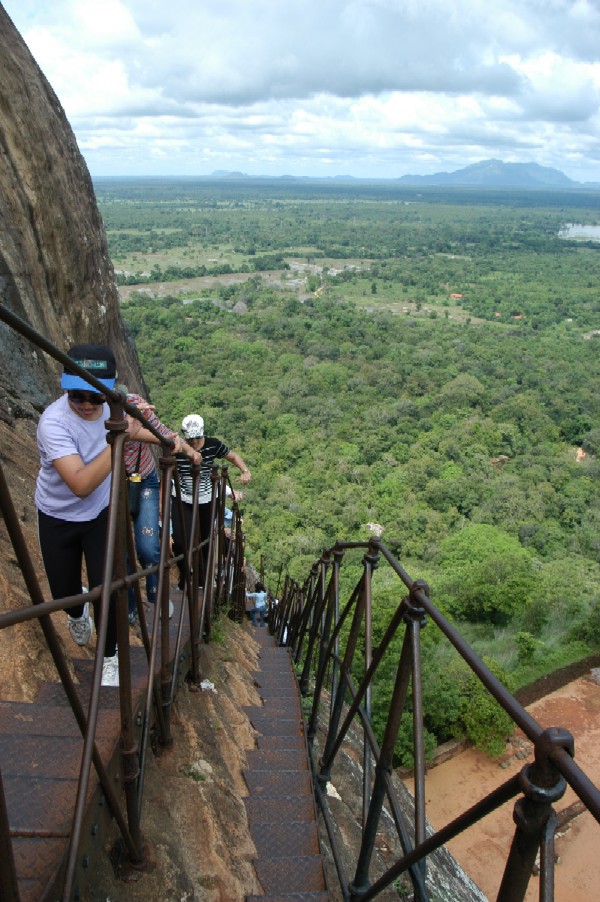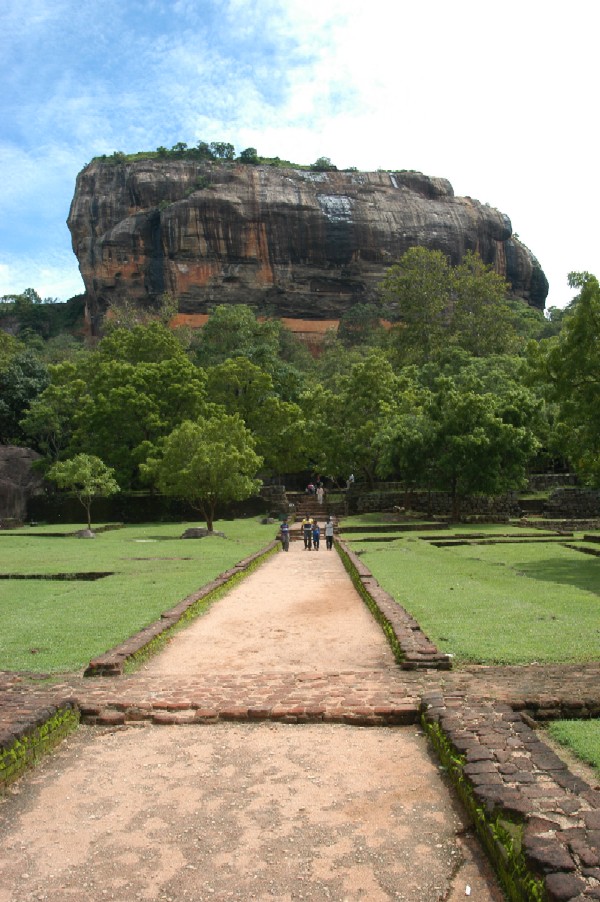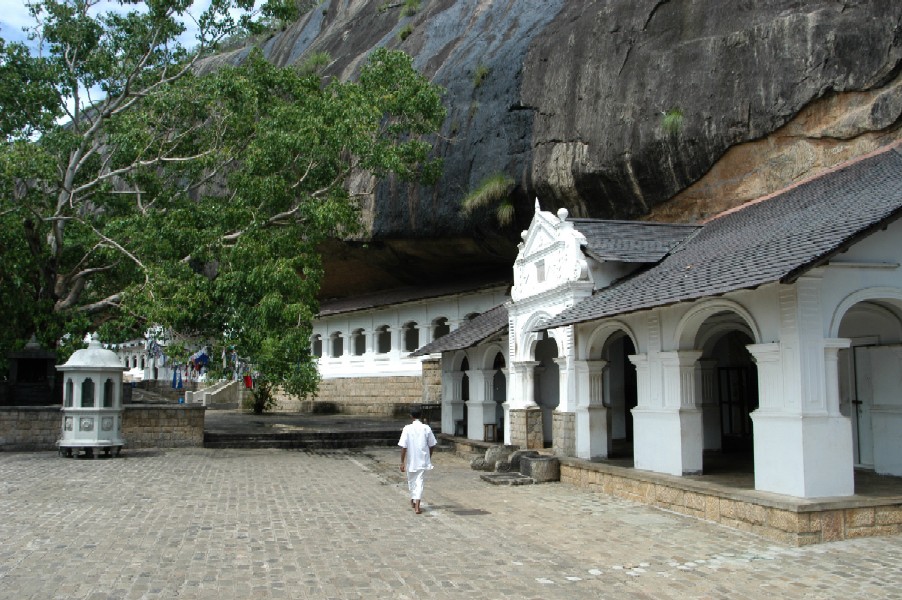November 7. SIGIRIYA - DAMBULLA - KANDY "From a Fierce Rock to Pious Caves" We awoke to dry clothes and nice weather, which was a great relief. We passed on breakfast and just checked out and headed to the bus station. It was Sunday and nobody was around in Polonnaruwa, not even the tuk-tuk drivers. We had to walked for a few blocks before we found one to take us over to bus station in the new part of town. There wasn't a direct bus to Sigiriya but we found a bus that could drop us at the highway turnoff where we could get a tuk-tuk the rest of the way. It wasn't a long drive and with the nice weather it seemed to go fast. Before long the bus pulled over and let us out in front of a cluster of tuk-tuks. We just wanted to get dropped off at Sigiriya but by the end of the ten minute ride we had a driver for the rest of the day. He was going to drop us a Sigiriya, wait for us, and then had to walked for a few blocks before we found one to take us over to bus station in the new part of town. There wasn't a direct bus to Sigiriya but we found a bus that could drop us at the highway turnoff where we could get a tuk-tuk the rest of the way. It wasn't a long drive and with the nice weather it seemed to go fast. Before long the bus pulled over and let us out in front of a cluster of tuk-tuks. We just wanted to get dropped off at Sigiriya but by the end of the ten minute ride we had a driver for the rest of the day. He was going to drop us a Sigiriya, wait for us, and then  drive us all of the way to Dambulla, farther down the main highway. drive us all of the way to Dambulla, farther down the main highway.
Sigiriya, a towering rock fortress that reached 200 meters high, could be seen all of the way from the main highway. Dating back to the time of Anuradhapura (5th c.), Sigiriya was older than Polonnaruwa and had less remaining structures but was an imposing place. The grounds were spread out around the base of the mountain but climbing to the top was the highlight of visiting Sigiriya. According to legend the fortress was built by Kasyapa, son of KingDhatusena of Anuradhapura. Kasyapa killed his father and seized the throne but fearing retaliation from his half-brother he built Sigiriya. That retaliation finally came but Kasyapa's end was anything but grand. His elephant got bogged in a swamp and, deserted by his troops, killed himself.
 The tuk-tuk dropped us at the main gate that entered onto the royal gardens, a wide expanse of water gardens, boulder gardens, and terraced gardens. The water gardens, stone bathing pools and moats surrounded in grass, covered most of the area. Looking up we could see a tiny trail of people making their way up the giant rock. The sky was clear and the weather steamy with humidity. My camera was still recovering from the day before and the moisture was fogging up my lens. As we got closer to the rock there was a large grouping of boulders lined up along the terraced walls that extended to the base of the rock. A combination of stairs and pathways traversed the face of the rock up to a platform near the top. Midway up the rock was a spiral staircase went up to a cave full of frescos called The Sigiriya Damsels. The 5th century series of paintings of beautiful women, called apsaras or celestial nymphs, were the only old nonreligious paintings still surviving in Sri Lanka. At one time there may have been as many as 500 portraits but just 22 remain today. We took our turn squeezing up the narrow metal staircase, thankfully enclosed with caged walls, to the small gallery. The images were quite lovely and it appeared The tuk-tuk dropped us at the main gate that entered onto the royal gardens, a wide expanse of water gardens, boulder gardens, and terraced gardens. The water gardens, stone bathing pools and moats surrounded in grass, covered most of the area. Looking up we could see a tiny trail of people making their way up the giant rock. The sky was clear and the weather steamy with humidity. My camera was still recovering from the day before and the moisture was fogging up my lens. As we got closer to the rock there was a large grouping of boulders lined up along the terraced walls that extended to the base of the rock. A combination of stairs and pathways traversed the face of the rock up to a platform near the top. Midway up the rock was a spiral staircase went up to a cave full of frescos called The Sigiriya Damsels. The 5th century series of paintings of beautiful women, called apsaras or celestial nymphs, were the only old nonreligious paintings still surviving in Sri Lanka. At one time there may have been as many as 500 portraits but just 22 remain today. We took our turn squeezing up the narrow metal staircase, thankfully enclosed with caged walls, to the small gallery. The images were quite lovely and it appeared that earlier viewers had been quite enamored with the ancient beauties as well. Along the long plaster wall that extended the length of the pathway below, ancient graffiti described impressions of the women in the cave gallery. that earlier viewers had been quite enamored with the ancient beauties as well. Along the long plaster wall that extended the length of the pathway below, ancient graffiti described impressions of the women in the cave gallery.
The pathway brought us to a large platform that stood about two-thirds of the way up the rock. It was a good spot to rest from the heat and exertion. Laying on the platform, extending from the rock above were a large stone pair of lion's paws, which gave Sigiriya its name -- The Lion Rock. The rest of the lion is gone but between the paws were more stairs that led to the top of the rock fortress. After cooling off a bit we began the final ascent up the more harrowing part of the climb. Beyond the lion's paws the stairs were reduced to metal scaffolding that clung along the edge of the rock with a railing on one side and the slope of the rock on the other, one foot walked along the metal scaffold while the other used the rock. Small footholds could be seen worn into the rock's face, the traditional way to climb I supposed, but the more mo dern method was nerve-wracking enough for me. For the last steep bit the stairs extended straight up the side of the rock to the top. The top of the rock covered 1.6 hectares but there wasn't much to see except for the foundations of the old palace. Built over several levels across the top of the rock the most notable remnant was the large water tank. From the very top we could see the far and wide. The rock stood quite solitary in the middle of Sri Lanka's jungle covered mountains. We met up with an English fellow that we'd talked with near the entrance and chatted for a while. He worked out of Singapore and was in Sri Lanka on business. dern method was nerve-wracking enough for me. For the last steep bit the stairs extended straight up the side of the rock to the top. The top of the rock covered 1.6 hectares but there wasn't much to see except for the foundations of the old palace. Built over several levels across the top of the rock the most notable remnant was the large water tank. From the very top we could see the far and wide. The rock stood quite solitary in the middle of Sri Lanka's jungle covered mountains. We met up with an English fellow that we'd talked with near the entrance and chatted for a while. He worked out of Singapore and was in Sri Lanka on business.
The descent was much easier and our tuk-tuk driver met us at the exit as planned. It was about 20km to Dambulla from Sigiriya which made for a rather exhilarating tuk-tuk ride! There wasn't much to the town of Dambulla and while we were hungry we didn't stop to eat and just had the driver drop us in front of the Cave Temple. We had hoped that there might be a place to eat near the entrance but there wasn't. The temple had a small cafeteria but it wasn't very inviting. The main temple building near the road was topped with an enormous gold Buddha. They claimed that it was the tallest Buddha statue in the world (30m high) but I had to wonder if that included the three story building that the statue rested upon. It was all fairly new and looked about as tacky as anything I had ever seen in Las Vegas. The building looked like a giant over-decorated Chinese restaurant and the statue looked like it was just plaster painted in gold. A set of stairs to the left of the building, flanked by fake-looking rocks, led up to the old cave temples. The whole place had somewhat of an amusement park feel to it. All it needed was a dharma coaster to take passengers on an expedited tour of the caves and finish the ride in a splashing pool of water nirvana. We were both hungry and tired so the final climb to the caves was almost too much. I had to stop for a soda, conveniently sold at a snack stand along the pathway, next to the row of curio carts. Where was the guy dressed in a Buddha costume for photos? over-decorated Chinese restaurant and the statue looked like it was just plaster painted in gold. A set of stairs to the left of the building, flanked by fake-looking rocks, led up to the old cave temples. The whole place had somewhat of an amusement park feel to it. All it needed was a dharma coaster to take passengers on an expedited tour of the caves and finish the ride in a splashing pool of water nirvana. We were both hungry and tired so the final climb to the caves was almost too much. I had to stop for a soda, conveniently sold at a snack stand along the pathway, next to the row of curio carts. Where was the guy dressed in a Buddha costume for photos?
Fortunately the caves at the top of the hill were well worth the effort. Unlike the cheesy modern part of the temple complex the caves were beautiful. A white facade marked the entrances to the five different cave temples, ranging in size from quite small to cavernous. About 150 Buddha statues adorned the caves with Cave II housing the most spectacular collection. The cave was 52m from east to west and 23m from front to back with the highest point in the cave reaching just 7m. A large reclining Buddha was the highlight but all along the walls of the temple were smaller statues with gentle lighting giving the cave an ethereal glow. The caves  were thought to date back to the 1st century BC but the colorful frescos that adorned the walls and ceilings of the caves were from the 19th century. were thought to date back to the 1st century BC but the colorful frescos that adorned the walls and ceilings of the caves were from the 19th century.
Retracing our steps back down the hill we ran into one of the British volunteers that we had met in Kandy. He had come all of the way up the hill and found out that the tickets were sold at the bottom. It would have been an easy mistake to make. We nearly missed the sign for the ticket office ourselves. He tried to pay for a ticket at the entrance to the caves but they wouldn't let him. They told him had to go all of the way back down and buy a ticket there. He refused and was just waiting while his travel partner went to see the caves. It all became rather frustrating the way tourists were fleeced in Sri Lanka and then provided such poor and apathetic service. When we talked with the British businessman back on Sigiriya we all agreed the the cost of traveling in Sri Lanka was beginning to outstrip its value. It was on the verge of not being such a budget destination with $20 entrance fees but the level of service was still at the budget level.
Before grabbing a bus back to Kandy we stopped for one last drink in the temple cafeteria but weren't brave enough to try the food. We were told the bus to Kandy would stop in front of the temple but while we waited we had a couple of tuk-tuk drivers try to convince us that there were no more buses for the day. They wanted us to take a tuk-tuk all of the way back to Kandy, a two-hour bus ride! I can't image how long it would have taken to go via tuk-tuk! Rob had fun joking with the guys and, in the end, they did tell us when the right bus came along. We were able to squeeze into a couple of fold-out middle seats that went down the aisle. It had been a very long day and I just couldn't help slipping into a fast sleep as the bus careened the corners along the road to Kandy. of the temple but while we waited we had a couple of tuk-tuk drivers try to convince us that there were no more buses for the day. They wanted us to take a tuk-tuk all of the way back to Kandy, a two-hour bus ride! I can't image how long it would have taken to go via tuk-tuk! Rob had fun joking with the guys and, in the end, they did tell us when the right bus came along. We were able to squeeze into a couple of fold-out middle seats that went down the aisle. It had been a very long day and I just couldn't help slipping into a fast sleep as the bus careened the corners along the road to Kandy.
We arrived back in Kandy just before sunset and it felt rather good to be back. Our first stop was at KFC to put something in our stomachs before heading back up to the McLeod Inn. We got an end room and quickly did a load of laundry in the sink so it had time to dry before we left the next day. Then we had some tea on that balcony! |

